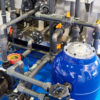Customers always ask me, what is so great about a Salt Pool ? (i.e. pools equipped with a chlorine generator or salt system) ?
I say, “How much time do you have?” It’s a complex question.
Too many homeowners today are having pools installed with these types of systems and they are either being completely misinformed by the pool builder, or they are failing to understand the concept at all before attempting to maintain their pool on their own.
Lets start with the undeniable benefits.
Benefits of Salt Water Chlorination
- Less need for “shocking” (or increasing the chlorine level to an abnormally high level to re-establish chlorine residual and sanitation to the pool).
- Less chlorine odor from water, provided the system is monitored properly and not allowed to overproduce
- A “softer” feel to the water while swimming.
- Less irritation. Since the chlorine produced is not a “packaged chemical”, it does not have the additives and by products that these chemicals have. These are often what cause the irritation, not the chlorine.
But there are several important myths and negative aspects of salt water chlorination that everyone should understand.
Myths About Salt Water Chlorination
Myth 1: It saves money in chemicals.
If you compare the cost of manufactured chlorine itself and the cost of salt to produce that chlorine, the money saved is small and it would take years for the savings to pay for the equipment. Also, there are a handful of other chemicals that you need to use, if you are maintaining your pool properly and practicing all of the basics of pool water chemistry. Overall, salt pools only lead to noticeable savings if the operator follows the instructions and monitors the system and the water chemistry consistently. Otherwise they will often waste any savings fixing problems due to a lack of oversight.
Also, in hot and/or rainy climates, you will have to run your filter pump a certain amount of time to produce the desired output from the cell. This can make a difference in the other operating costs of your pool.
Myth 2: Salt pools require almost no effort or maintenance.
This is the most common misconception and it is completely false. It is my personal opinion that salt pools involve just as much oversight, if the goal is to have your pool properly balanced and sanitary. This is why many homeowners often have a green pool 6 weeks after their pool has been completed, because they have never checked the salt level or tested the water. People often end-up with stains and damage to their new finish as well, because they also fail to test and adjust PH levels during this period. The first 6 weeks of the life of a pool finish are critical. NEVER attempt to establish the initial salt balance in the pool or run the chlorine generator until your pool has been filled and treated, with traditional chemicals, for at least a month or however long it takes the finish to cure.
Furthermore, there can be a drastic difference in the proper output level, given the time of year and weather. Too often, people fail to lower the output when it is cold or dry, or the fail to increase the output when it is hot and rainy. The result is either a messed-up pool or a complete waste of the chemicals that they are supposed to be saving with the salt system.
If you don’t keep the filter clean for adequate flow or if you don’t service the cell when it is required, the cell can shut-down and not produce. A lot of people ignore this responsibility and have problems.
Negative Side Effects
Several negative side effects of salt water pools are now being addressed by people within the service industry.
Salt systems can make PH balancing difficult from week to week. If not handled properly, it can be a problem. Always check PH and Alkalinity together, before doing anything else. Follow directions properly, by always doing what is appropriate for Alkalinity first, because these two things can often lead you in opposite directions. Don’t set the chlorine production level any higher than it has to be, because the more the cell runs, the harder it will be to keep these two things balanced.
- Scaling, from high PH and/or Alkalinity (explained above)
- Corrosion. You can have damage from low PH, but also the salt content itself accelerates corrosion to a degree, and therefore some heaters and newer stainless steel filters are not designed for use with a salt system.
- Cell cannot produce enough chlorine to meet demand. The two most common causes of this problem are:
- A. A larger cell should have been installed for the situation or size of pool.
- B. The water is contaminated with nitrates, phosphates or other organic compounds that need to be removed from the water.



